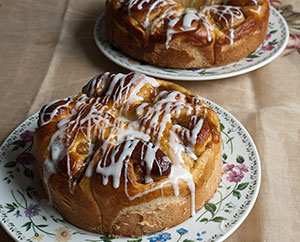
Apple Bread Ring
| Ingredient | one 9" and one 7" ring | one 23cm and one 18cm ring |
|---|---|---|
| Bread | ||
| bread flour | 1 pound | 450g |
| eggs | 2 | 2 |
| milk | 7/8 cup | 210 ml |
| butter | 4½ Tbsp. | 4½ Tbsp. |
| sugar | 4½ Tbsp. | 4½ Tbsp. |
| salt | 1 tsp. | 1 tsp. |
| active dry yeast | 1¼ tsp. | 1¼ tsp. |
| Filling | ||
| apple pie filling | 500g | |
| Finishing | ||
| egg | to brush | to brush |
| powdered sugar | 2½ oz. | 70g |
| milk | 3 tsp. | 3 tsp. |
This ring of apple rolls is a fluffy, apple-rich take on the bakery favorite, substantive enough that it won’t feel like you’re eating dessert for breakfast. It uses a bread machine to take a lot of the work out of the process, but is hand finished so nobody will know.

Preparation
- Prepare one batch of either apple pie filling or caramelized apples; cut the apples into smaller pieces than you would for pie filling.
- Butter the sides of two ring-shaped pans, then cut a piece of parchment paper to fit the bottom of each and lay it in.
Directions
- Prepare dough.
Put all the bread ingredients in your bread machine as you would for a normal loaf of bread. Run the machine on its bread dough preparation cycle, using the setting to stop before baking. - Punch down.
When the machine has finished the dough prep cycle, turn the dough out onto a floured work surface and punch down. - Divide and let rise.
Fold the dough in thirds, as you would a letter to fit an envelope, then divide into two parts to fit the pans, about three fifths and two fifths. Form the two portions into balls and put a thoroughly wrung-out moist towel over each, then let rise in a warm spot for fifteen minutes. - Roll out dough.
Starting with the larger portion, roll the dough out into a rectangular sheet about 40cm by 30cm (16" by 12"). Spread about three-fifths of the apple filling over the surface of the sheet of dough, leaving a little dough exposed around the edge. - Roll up.
Roll the sheet into a cylinder along the long side. Pinch the dough along the seam to hold it closed, then put the seam on the bottom and adjust the shape into a tidy cylinder. - Cut dough and arrange in pan.
Cut the cylinder of dough into 7-8 slices. Place the sliced pieces into the pans, with the flat sliced edge down and the seam on the inside, pointing toward the pan’s chimney. Push them down to flatten out as necessary to get an even surface across all the slices in the pan. - Repeat.
Repeat steps 4 through 6 with the remaining dough, rolling it out into a 30cm by 25cm (12" by 10") sheet and cutting it into 6 slices. - Let rise again.
Let pans rise uncovered for 50 minutes, until the dough has expanded to roughly double the starting size. - Glaze and bake.
Scramble an egg and brush the top of each ring to coat; it will probably take about half an egg total. Bake at 350°F (180°C) for about 30 minutes, until golden brown. Once the bread has cooled to the point you can handle it comfortably, remove from pans. - Frost.
Let the bread cool completely, then mix together the powdered sugar and milk for the icing. Generously drizzle the icing on the top, slice and serve.
Notes
- You can replace the milk in the icing with an equal amount of lemon juice, if you prefer tangier rolls.
- The proportions above are enough to make a 23cm (9") and an 18cm (7") ring; if you have different pans on hand adjust accordingly. Chiffon cake pans have a nice flat bottom, but you can also use bundt pans, in which case omit the parchment paper.
- When letting the dough rise outside the bread machine, unless it’s hot in the room you can use the raise function on your oven, if it has one, or if not turn it on just until it gets warm inside then turn it off and put the bread in to rise.
